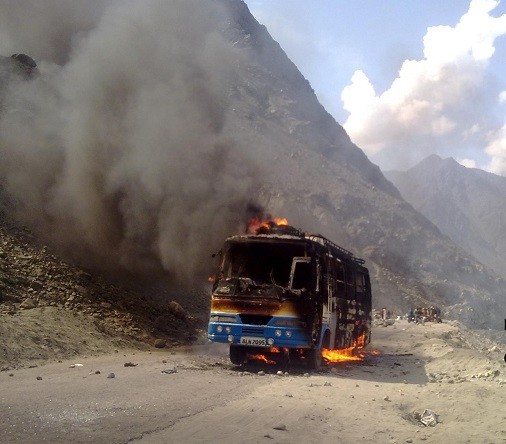
Terrorists are expanding their footprints in Gilgit Baltistan at a frightening pace

A menacing pattern of multiple attacks swiftly expanding into different parts of the Gilgit Baltistan (GB) has unfolded since early August. It started by attacking several schools, police and a judge at Darel Tangir, in district Chilas and then shifted to Gilgit where terrorists attacked schools again and now they have centred their attacks at Ghizer which is the crossing point between Chitral and Gilgit, virtually haunting the entire Shia and Ismaili population of an ugly spectre ahead of Muharram.
The terrorists are expanding their footprints at a frightening pace to "harass and neutralise" both the community and the state as the security apparatus waits to react to the next one.
The Gilgit Baltistan is criss-crossed by sectarian fault lines often rattling the vulnerable territory sharing borders with India, China and Tajikistan and Afghanistan.
The beauty and serenity of the breath-taking valleys and high mountains, the valleys with lakes and the beautiful rosy cheeked people, is not without its share of the tragedies. The ghosts and the demons of sectarianism lurk in the dark shadows ready to pounce. The Gilgit massacre of 1988 in which nearly 700 people were killed transformed the region, ripping away its tranquility and years of peaceful coexistence of the different communities.
With almost a proverbially ‘non existent’ crime rate, the police were trained in watch and ward kind of enforcement, but as the crime metamorphosed into armed violence and terrorism in the 21st century, the local force was found lacking. The Gilgit Baltistan is very vulnerable as the police and its leadership is neither oriented nor equipped in counter terrorist tactics despite being in the gun sights of the most lethal breed of criminals since the late ‘80s.
Coupled with occasional pricks, in 2005, a major spate of violence rocked the area with senseless killings over change of school curriculum. Then 2012 visited the region with vengeance, when a bus load of Shias travelling to Gilgit was mowed down in Kohistan, followed by string of bloody incidents in Diamir and in Babusar Valley of the neighbouring Mansehra. In 2013, the terrorists struck 11 foreign mountaineers at the Nanga Parbat base camp and escaped to Afghanistan through the mountains with ease.
Against this backdrop, the governments throughout had little inclination to address the capacity building of police personnel and its command. In fact the Gilgit Baltistan police received the rifles, Kalashnikovs and related ammunition from the army chief Gen Ashfaq Pervez Kayani at the initiative of one of the IGs in 2011. Much has not changed since then. Even today the top police command has serious issues of comprehending the challenges and unable to inspire confidence among the middle and the junior ranks.
Next, the police-intelligence collaboration on specific and timely information leaves much to be desired. Besides, there is also no round the clock monitoring and tracking of the myriads of mountain passes from Afghanistan to Chitral and Ismaili-dominated Ghizr.
According to security officials, the terrorists are largely using two routes to enter Gilgit Baltistan. From Afghanistan’s Nangarhar province, through Chitral they infiltrate into Gaukush and Ghizr district of Gilgit. The other frequented route remains from Chilas into the main Gilgit-Baltistan. The surveillance requires manned posts in the mountains with personnel equipped with alpine uniforms to withstand the rigours of extreme cold and effective side arms and long range weapons, besides deploying the readily available hi-tech solutions of surveillance drones and helicopters for aerial support.
Daimer is the gateway to Gilgit-Baltistan but considered part of the hardcore Sunni belt due to adjoining KPK four districts of Upper and Lower Kohistan, Shangla Par and Battagram. Security sources concur this district, with Chilas as its district headquarter, has been used by terrorist as a staging area since the mid-‘80s.
In August, Chief Minister Gilgit-Baltistan Hafiz Hafeezur Rehman confirmed the presence of ISIS/Daesh terrorists in the region. Later, the IG GB Sanaullah Abbasi also confirmed the attackers to have been trained in Afghanistan. The Punjab CTD has conservatively estimated them to be over 1000 in number, while drawing the caution that "many more are entering into different parts of Pakistan."
Security sources believe the ISIS-Daesh elements in the GB "have recruited local sympathisers and sleeper cells of the erstwhile Hafsa Brigade, the defunct Lashkar-e-Jhangvi and TTP." A group leader of Jamiat ul-Ansar, Khalilur Rehman, was killed by police. But that led to no headway as the police could not gain timely access to cell phone records that allowed the accomplices to escape. The actionable intelligence is a perishable commodity often giving a "narrow time bar" to act and failure to take effective action within that time period renders it futile.
This calls into question why the police do not have the mobile phone trackers and independent access to cell phone records to timely react to a developing information. A wide ranging operation is needed to insulate the local population from the marauding ISIS or terrorists of any hue, while gearing up police and the intelligence coordination.